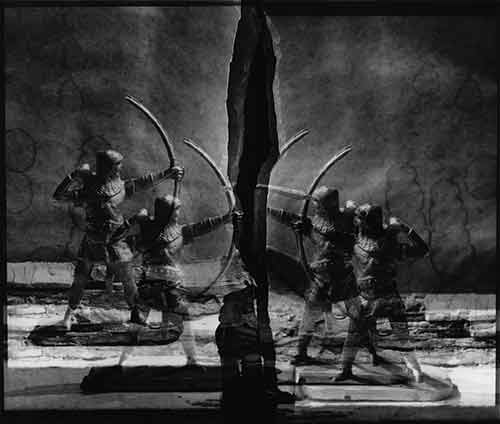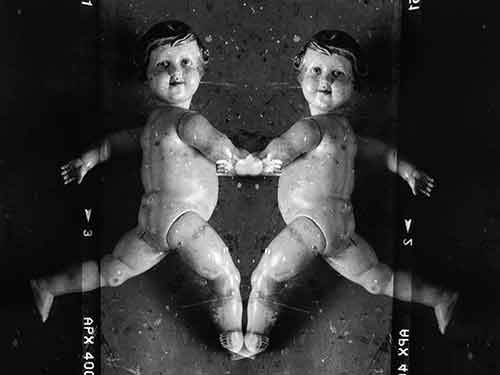 |
 |
 |
 |
 |
|
from the series War Games, 2000 |
| Waldemar Jama's Art In the 21st Century |
| Waldemar Jama belongs to one of the most mindful Polish artists, active principally in different branches of photography. What is interesting about him is that he is not confined neither by a documentary approach, nor by staged photography, and regardless of the techniques he uses he always follows his own imperative which serves to broaden his artistic awareness that has been either denying or widening the interpretative field of his most recent works1. About Jama's art, who began his career in the 1960s, I have written a few papers, also in the context of Silesian independent culture2. In the text entitled In the Search of the Lost "Aura" I interpreted his works as follows: "Since the 1960s Waldemar Jama's art evolved in various directions. He was interested both in pure, as well as metaphorical, and later media photography which examined the relations of a natural sign that became a whole system in neo-avant-garde art later (for example Jama's series called Registration, from 1981). [...] he never had a master or an artistic model to emulate. He adopted a "parasitic" (his term) attitude towards the avant-garde which dominated photographic life in Poland in the 1970s and 80s. The avant-garde produced very diverse material which Jama used in his further plastic operations, as he is both a photographer and, most of all, a plastic artist whose aim is the picture that usually resembles a painting, sometimes a poster (see, for example, his series called Pandora's Box)..."3. The 21st century saw further development of his art, but at the same time it reached a new stage of critical and visual meaning - which I shall discuss here in my interpretation. We shall see what became of his photography, using the example of four series of photographs that at least for the time being do not belong to a consistent system of seeing and studying human perception, but we are living in different artistic times. In Jama's new approach we can discern a deeply rooted, critically conceptual tone, connected with the search and recall of the postulation of "new seeing" that was so significant for the constructivist approach, marked by the names of Władysław Strzemiński and - in the aspect of photography - of Laszló Moholy-Nagy. Peripheries There was a time when a similar photographic problem interested Aleksandra Mańczak. And certainly artists will return to such analyses, as the notion of the centre with its magnificence and stability becomes nauseating after a while. Whatever might influence some style, tendency or fashion in the future, must be looked for in the fringes, but the difficulty lies in the fact that very few theoreticians and historians can long observe what still merely looms on the horizon now and is difficult to define in the chaos of life and transformations that take place in the peripheries - because the instability of the system causes continuous changes. Jama tackled precisely this problem when he photographed bill-posts at the height of a few dozen centimetres above the ground. What does the author of "different seeing" see and tell us here? We can see the remnants of consumer culture, in other words, advertisements of zero degree, according to the theory of Jean Baudrillard. Fortunately this culture is short-lived, although its products are mainly responsible for the depravation of the human mind, since they constantly dupe and deceive us. As far as I am concerned, the most important element of Jama's works is the problem of the existence of "something" at the bottom of the pictures, for example, curbstones, while what is changeable and accidental is also barely visible - like torn posters, illegible, though recognizable. In this way the artist revealed the paradox of visuality.. The Paralax (According to Bellmer) This series is a quotation from Bellmer, not his mocking pastiche. Jama, using solely photographic means, mainly the photo-montage of negatives, achieved similar results as Bellmer in his complex work, partly sculpture, partly photography and partly painting, in which the most significant factor was the play and staging of a doll, conducted by means of complicated manipulations, inluding some of quasi-magical character. In this way Jama's series became a part of the world history of references to one of the most influential surrealists that Bellmer remains to this day. In the 1930s of the 20th century he revealed that the absolute possesion of the body and control over it becomes not only an artistic, but also a life obsession which was the source of one of the most important works of the 20th century - Etant donnes (1946 - 1966) by Marcel Duchamp, produced secretly and referring to the sexual desire of the female body. The series by the Polish artist shows how to allude to Bellmer photographically, and thanks to the simple rearrangement of negatives produce an ambiguous, oneiric image that continues to ask the same important questions that the German surrealist asked, although without the kind of artistic risk, involved in the showing of the two series of Dolls. Traps The technique of the photogram and its modifications in Poland are rarely explored artistically in Poland. Why? Most of them follow the fashion marked by the camera obscura or wet collodion technique. Waldemar Jama produced some of his works employing the method of the photogram - using, as he rightly remarks, "whatever was at hand" - and utilizing pieces of transparent fabric was able to describe reality, which is not that simple and easy any more. Thus he shows a civilizational clash, the possibility of a world war, but also more formal systems in the tradition of the modernism of the 1920s and 30s. He also tells a story about specific Polish reality and the political changes in our country, using to this end a metal eagle from a soldier's cap or other such accessories. This series is characterized by symmetrical, central composition and versatility, with both sharp and out-of-focus images building an ideogram that is rather a sign and a negative visual form than a mimetic photograph. I hope that this series will make some artists realize that there are other possibilities of using old photographic techniques. War Games Since 2001 we have been living in the atmosphere of conflict, feeling that the terrorist threat draws nearer to Europe and even Poland. Jama's series also has a cultural meaning that refers to the educational system in which boys for generations have been learning to play war games, and therefore, getting accustomed to... killing. This mechanism, alas, has been encoded by our imperfect civilization - Zbigniew Libera pointed out this fact in his most important work of the 1990s called Lego. A Concentration Camp, and in a later work, entitled Eroica. The problem has not been and cannot be resolved at this time - but the job of the artists is to pose questions, even in an absurd form, not to answer them. Answers and solutions are the responsibility of politics. In these photographs that make up the most theatrical and painting-like series by Jama, we notice the use of very diverse artistic means, including old photographs which have been contrasted with the main motif. The artist uses long exposition time and his goal is to point out symbols, like the egg, the symbol of life, shown among soldiers who can be a metaphore of protection, but also of extermination and destruction. Jama expertly utilizes the method of juxtaposing and contrasting the accessories he uses. An example may be a figure of a knight, presented among clouds against the background of skyscrapers from an American city, or an old photograph of a little boy with a rifle(!), contrasted with shooting tin soldiers. Three of them - how awful - have lost their heads! This extraordinary conceptual comparison and its ideological clash with the photograph of the boy seems an extremely appropriate metaphor here. Pictures from this series, exceptionally expressive and visually beautiful, even pictorial, are also a warning against war. Cosciousness and imagination are vital Since the 1990s Jama has been using several conventions; he does not care for any homogenous style that was demanded in the times of modernism. Postmodern freedom allowed for the pluralistic use of different conventions and styles. But as far as looking at the world and its critical analysis are concerned, both in the world of advertising and within the range of our conventional vision, Jama works according to the postulations of the first wave of modernity. That is why he is interested in the broadening of the visual and ideological potential of photogram technique. And in showing of what we do not want to see at the bottom of bill-posts. He makes us reflect yet again on the idea of "soldiers" who, in his interpretation could be the four Riders of the Apocalypse, in the cultural, not religious sense. Jama, like me, believes that in order to produce significant artistic works one must unswervingly develop and improve one's artistic consciousness and imagination, because intuition, in the face of the acceleration of the development of changeable artistic phenomena and their intellectualization, does not suffice any more, unless one wants to be a so-called naive artist. |
Krzysztof Jurecki
|
|
1 The most important album publication, showing the transformations of Jama's art, contains all of his most significant series from the 1960s until the beginning of the 21st century, entitled Waldemar Jama. Fotografia [Photography], published by the Academy of Art in Katowice et alia, Katowice 2002. 2 K. Jurecki, W poszukiwaniu utraconej "aury" [In the Search of the Lost "Aura", [in:] Waldemar Jama. Wizerunki [Effigies] 3, Galeria FF, 1995, (catalogue of the exhibition); O etosie fotografii. Na przykładzie kilku fotografów ze Śląska, [On the Ethos of Photography. The Example of Several Photographers from Silesia] "Kwartalnik Fotografia" [Photographic Quarterly] 2004, nr 15, Inscenizacja czy dokument? [Staged Photography or a Document], "Exit", 2000, vol. 2, and [in:] Katowicki underground artystyczny po 1953 roku [Artistic Underground in Katowice after 1953] (J. Zagrodzki, ed.), Galeria Sztuki Współczesnej BWA [Gallery of Contemporary Art, Bureau of Artistic Exhibitions, Katowice 2004. 3 K. Jurecki, W poszukiwaniu utraconej "aury" [In the Search of the Lost "Aura"], op. cit. |
 |
 |
|
from the series The Paralax (According to Bellmer), 2002 |
 |
 |
|
from the series Traps, 2008 |
 |
|
from the series Peripheries, 2005/2006 |
Copyright ©2011 Galeria FF ŁDK, Waldemar Jama, Krzysztof Jurecki |